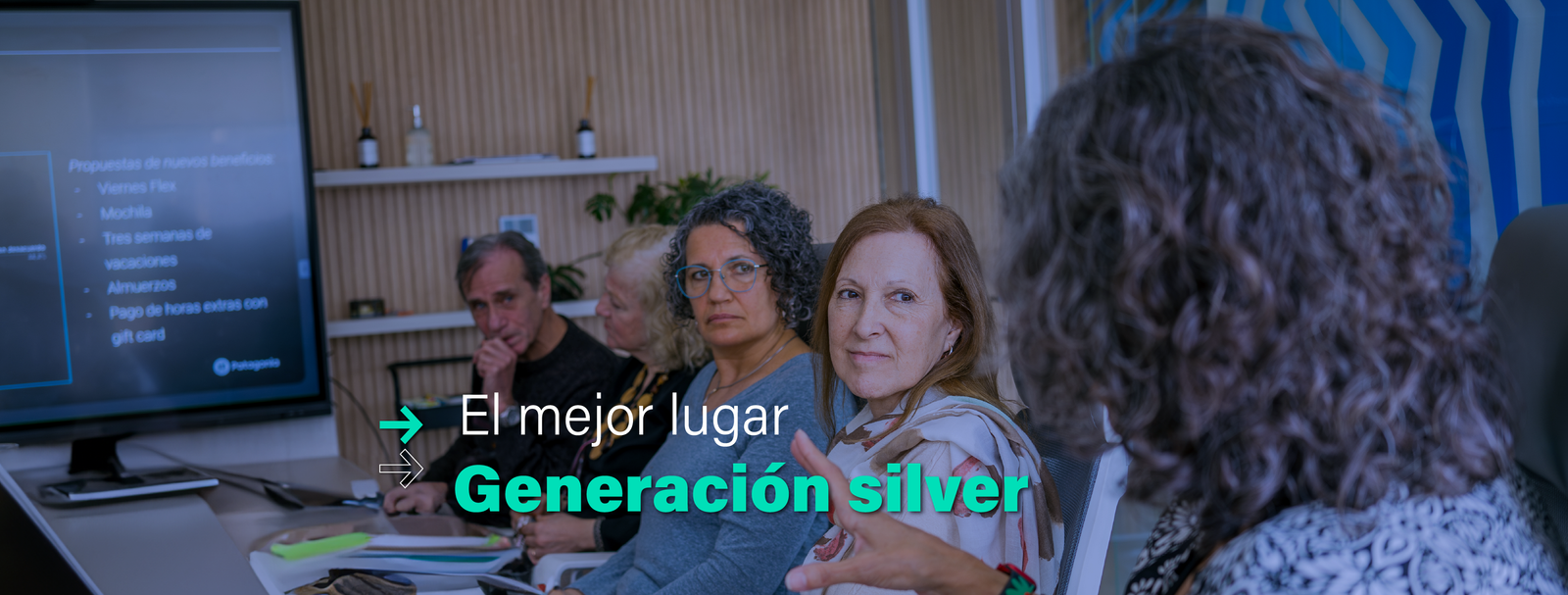Silver Generation: A Decisive Factor for the Technology Industry
We live in a time when four generations coexist in companies for the first time in history.
Centennials, millennials, generation X and baby boomers They share work spaces, interacting with their differences and complementarities.
In addition to posing great challenges, this generational coincidence shows an extension in human productive capacity.
Today, a person between 55 and 65 years old is in a perfect moment to provide accumulated experience, adaptability, knowledge and motivation to meet new challenges.
In addition, it offers a combination of three characteristics that are not usually present in younger generations: loyalty, stability and commitment.
While in many industries people over 50 find it difficult to maintain their employability or re-enter the labour market, the technology sector offers a field of development with a high demand for senior talent.
In this article we analyze the employment prospects and challenges for the Silver generation, and the opportunities presented to them by the IT sector.
We also discuss the importance of diversity, inclusion and integration in productive areas, as well as the success model of IT Patagonia.
Who makes up the Silver Generation and what are their characteristics?
The Silver Generation refers to people who are 60 years old or older and who are actively working.
Unlike previous generations, members of this generation are more involved in professional activities, tend to take advantage of digital tools, and are interested in continuing to learn and share their experience.
Those who are part of this age group bring a strategic vision based on years of practice, which allows them make well-informed decisions with a long-term focus.
Furthermore, their role as mentors is crucial in intergenerational teams, where they help train and guide younger talent.
Another distinctive feature is their willingness to continue learning and adapt to new environments, which includes the use of technological tools.
Many members of the Silver generation have embraced continuous learning as part of their professional development, allowing them to adapt with relative ease to emerging technologies.
They also tend to have a more balanced approach to work, and the tendency to seek quality rather than quantity.
Along these lines, they prioritize collaboration and communication in their teams, and bring maturity and stability to work dynamics.
Another distinctive aspect is that they stand out for their responsibility towards work, commitment, experience, resilience, patience and dedication. All of these are characteristics that They bring great value to the business.
Labor market: prospects for the Silver generation
Even though Latin America is a relatively young region, the participation of older adults in the labor market is notable.
So it is Inter-American Development Bank (IDB) reports, which highlights that approximately One in four people active in the labour market is over 50 years old.
According to forecasts made by Adecco, by 2050, the global proportion of people aged 65 or over will double from the current 8.5% to 17%.
In parallel to this growth of senior talents, Oliver Azuara, senior economist in the IDB's Labor Markets Division, highlights that in Latin America and the Caribbean, A significant proportion of the workforce does not retire after retirement age. On the contrary, continue to generate income.
Why? One of the reasons for this trend mentioned in the report is the absence of adequate pension systems or benefits that are not sufficient for ensuring financial security in later life.

These data are reflected in the surveys conducted by the IDB's Digital Social Security Laboratory, in which the population assumes that they will be able to continue working beyond retirement age.
Similarly, an Adecco report on employability in people over 55 years of age indicates that in Argentina the retirement peaks at 60 and 65 years of age no longer exist, given that people choose other strategies and times to retire.
In addition, the shortage of workers in certain segments, such as the case of Cobol and Mainframe specialists, can create more opportunities for older people.
Especially for those members of the Silver generation who are interested in staying active in the workforce to meet professional challenges.
In terms of employment, in Argentina Only 2 out of 10 job offers include people over 45 years old, when it is estimated that There are about 800 thousand in that age group who are seeking to re-enter the labor market..
This leads us to consider, as Adecco maintains, that social perception surveys and productivity studies indicate that knowledge and experience – the main indicators of performance at work – tend to continue increasing over the years, even after age 80.
To add further light to the analysis of the value contribution of the Silver generation, the Organisation for Economic Co-operation and Development (OECD) found that A company with 10% more employees aged 50 is 1.1% more productive.

Employability challenges for the Silver generation
Organizations need Recognize the value of more experienced people.
Those who approach or exceed the barrier of 50 and even 60 years, begin to encounter obstacles to survive, re-enter the job market or change career direction.
“As we know, no generation is immune to age-related prejudices. As the generation grows, the stereotypes that most affect us are those that question our ability to adapt, agility and compete with new technologies,” he says. Carolina Olivera, People and Sustainability Officer IT Patagonia.
Adecco points out that in the 75% of companies, people over 55 years old do not have inclusion policies. An absence that favors the development of biases and erroneous ideas related to the fact that older people:
- They are obsolete.
- They have no digital skills.
- They couldn't stand having a boss younger than them.
- They resist changes.
- They aspire to very high salaries.
These prejudices are further exacerbated if companies do not generate the data necessary to quantify the performance of their teams, which allows them to identify the capabilities and potential of older talent.
“Women face additional barriers, which also intensify with age.. These difficulties begin to increase after the age of 40, especially when they try to reintegrate into the labor market after motherhood,” Carolina emphasizes.
“Although there has been progress and a more positive perception of motherhood, women still face significant obstacles, which are further aggravated in cases of periods of inactivity or when trying to change careers,” she adds.
It is therefore important for companies to evaluate each particular case, understand the risks involved in making decisions based on stereotypes and Learn to discover the unique abilities of each generation.
Technology: a sector of opportunity for the Silver generation
As we have been explaining in previous articles, we are experiencing a scenario with a Demand for IT talent exceeds available supply.
In this context, and faced with the imminent retirement of senior talent, it is often necessary to hire young people with little experience and train them in technologies widely used by companies, which are no longer taught at universities.
Or, retrain people who are already working within the organization so that they acquire new skills. For example, training members of the Silver generation to incorporate knowledge of emerging technologies.
From the portal Infojobs confirm the trend, indicating that recruiting IT profiles is one of the most difficult to carry out.
This fact becomes even more relevant when it is reported that positions in the technology sector have continued to be on the list of categories with the most vacancies in the last decade.
High competition for talent presents significant challenges for organizations. Especially in niches where Availability of professionals is reduced year by year.
Diversity, inclusion and integration for business growth
The coexistence of so many generations together in the work environment forces companies to rethinking talent management with an eye toward integration, but also in relation to business growth.
“In the IT sector, where I have worked for more than 15 years, the need to attract talent opened the door to inclusion, diversity and intergenerational coexistence, and we continue to move in that direction. Today we can attest to the good results that diversity brings to organizations and how it improves talent management practices.“, says Carolina.
Based on our experience and knowledge, we can assert that Silver Generation professionals can act as mentors to younger teams, sharing their learnings, knowledge and best practices, and broadening the diversity of perspectives.
This interaction is very positive, as it encourages innovation and better decision making. And it is about a highly valued accompaniment, which strengthens intergenerationality.
On the other hand, it is important to note that when hiring professionals over 50, it must be taken into account that age does not prevent the learning curve.
For Carolina, “if a person decides to change career, regardless of their age, they will start in a junior position. That is why it is vital that the organization Create a career plan that allows you to develop in the new field“.
However, professionals with long experience have additional tools, especially to face difficulties.
This is why companies must develop initiatives to create diversity in their teams, both for younger generations looking to access their first job, and for people over 50 and over 60, who feel they are being left out of the labour market.
Having this approach to inclusion and integration is, without a doubt, also beneficial for the business. Hiring people over 50 and 60 years old not only enriches the diversity of the team, but also brings experience, stability and new perspectives.
“It is crucial to break with the myths and stereotypes associated with age and focus on the skills and value that these professionals can bring. Fostering an inclusive and generationally respectful environment is highly beneficial for organizational culture and business success in general,” says Carolina.

How do we develop talent at IT Patagonia?
For more than 35 years, we have been dedicated to developing IT talent and Form teams specialized in the technologies that the industry needs.
Based on this experience, we developed a working methodology that includes four key phases:
- Survey: technical and soft aspects of the profile that needs to be filled are analyzed, as well as the organizational culture of the organization in relation to that position.
- Feasibility: the match between the ideal profile and the available offer is evaluated, with the support of experts.
- Investigation: We involve the best specialized hunting methods, tools and platforms.
- Match: We determine the ideal technical profile, which includes a description of the future skills required for the position, with special emphasis on orientation towards change.
Through this methodology, we have already More than a thousand people trained by more than 25 teachers and mentors, and we teach more than 15 technological specialization courses.
Always from a gender perspective, with a age-inclusive vision, and in alliance with other organizations.
Conclusion
Stereotypes about the adaptability and technological competence of people in the Silver Generation must be challenged.
These professionals bring experience, commitment and stability, three essential factors for the sustainability of the business.
This requires creating initiatives that promote inclusion and take advantage of the unique skills of each generation, creating mutual benefit.
Companies must adapt to manage talent in an inclusive way, recognizing the value of professionals of all ages. This will strengthen organizational culture and improve business results.
Are you interested in learning more about the IT talent training service that we carry out in association with the edtech codeki?

